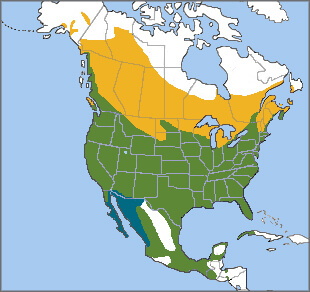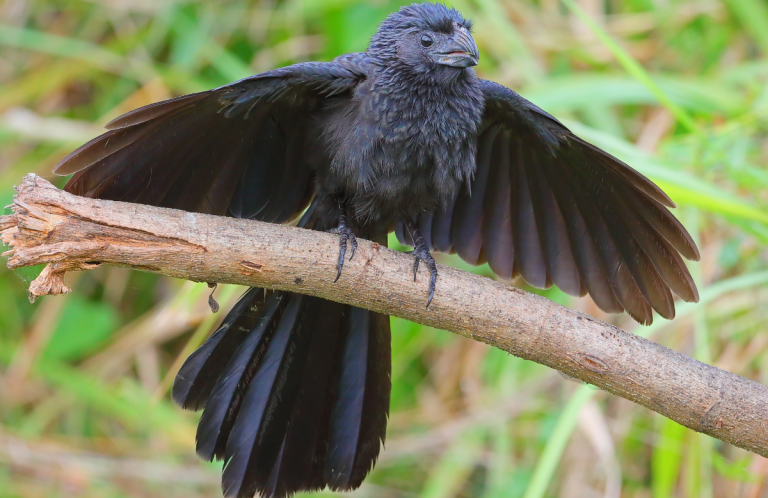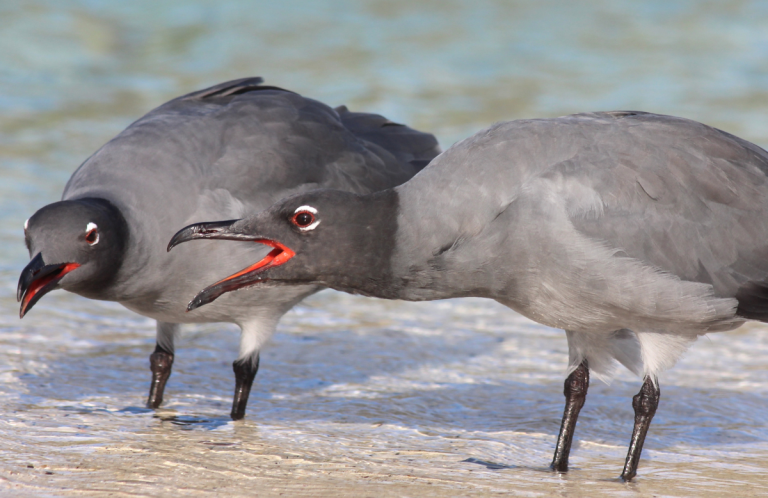
Red-winged Blackbird map, Birds of North America, https://birdsna.org maintained by the Cornell Lab of Ornithology
The liquid, burbling "conk-a-ree!" of a male Red-winged Blackbird on territory is a sure sign of spring, or at least its pending arrival. This bird's common name derives from the sleek black males' distinctive shoulder patches, or epaulets, which flash red in flight and while the bird is singing on territory.
The Red-winged Blackbird belongs to the family Icteridae, which includes the Eastern Meadowlark, Tricolored Blackbird, Rusty Blackbird, and Baltimore Oriole.
A Brash Bird's Secret Life
Red-winged Blackbirds are sexually dimorphic, meaning males and females have very different appearances. They also play very different roles during the breeding season.
Breeding males stand sentry, ceaselessly singing and chasing intruders. Meanwhile, the streaky brown females — easy to mistake for large, pointy-billed sparrows — skulk in nearby vegetation, stealthily building nests, laying eggs and incubating, then doing much of the feeding of their young.
(Audio by Paul Marvin, XC448823. Accessible at www.xeno-canto.org/448823)
But it's usually not just one pair that occupies a territory. This species is polygynous, meaning that one male will mate with and share territory with more than one female. Red-winged Blackbirds usually nest in loose colonies, with a male attracting up to 15 females to nest within a territory. And there's another wrinkle: Females frequently mate with males other than the territory holder, and so they often lay clutches of unknown paternity.
Males chase and mob intruders of all sizes — not only competing males, but also Great Blue Herons, crows, and raptors, and even people wandering too close to their nests.
Each breeding female may raise two or three clutches per season, building a new nest for each clutch. These reconstructions likely occur because new nests are sure to be free from parasites that could weaken or kill baby birds.

Red-winged Blackbird by Josh Bukoski, Shutterstock
Nesting is a dicey game of hide-and-seek in the wetlands and fields where Red-winged Blackbirds breed. They tend to nest close to the ground, within predators' reach. The females' brown and streaky coloration helps to camouflage them at and near their nests, which are usually concealed in thick reedy vegetation, often over water. Group nesting and individual birds' diligence and aggression toward intruders provide some added security.
Widespread Wanderers
The Red-winged is the United States' and Canada's most widely distributed blackbird, with approximately 20 recognized subspecies. Most are very similar in appearance, with males having a pale yellow border at the epaulet's bottom edge. The red epaulet is sometimes concealed until the bird takes flight or exposes it while on territory, but the pale yellow shoulder slash is always visible. There is an exception, however: Three subspecies found in parts of California and northern Mexico are called “Bicolored Blackbirds” because males lack the yellow border and only have red epaulets, while females are a solid blackish brown instead of streaked.
The related and similar Tricolored Blackbird also occurs in California. At rest, this species shows a white shoulder slash, which borders a red epaulet seen in flight and display.
Sign up for ABC's eNews to learn how you can help protect birds
Red-winged Blackbirds are omnivorous, feeding primarily on seeds and waste grain such as corn and rice; some small fruits such as blackberries; and also a wide variety of insects and spiders, particularly during the breeding season. Their diet varies depending upon habitat and opportunity, and these blackbirds eat various other small animals and carrion as well. Red-winged Blackbirds will visit backyard bird feeders, especially in the winter, for seed and suet.
Northern populations migrate southward in fall, flying during the day. During migration and in winter, flocks can be enormous, consisting not only of Red-winged Blackbirds but also other blackbirds, grackles, cowbirds, and starlings.
No Safety in Numbers
The Red-winged Blackbird's scientific name Agelaius phoeniceus derives from Greek, meaning, roughly, “scarlet flock member,” referring to the male's wing patch and the birds' social habits. Still one of North America's most abundant birds, the Red-winged Blackbird is nonetheless a concern for conservationists. Outside breeding season, Red-winged Blackbirds and other blackbirds are frequently targeted at their large roosts in agricultural areas, where the birds can cause significant crop damage. (The Bobolink is persecuted on its South American wintering grounds for similar reasons.)
For decades, control measures such as poisoning, trapping, and shooting, along with habitat loss and climate change, have resulted in a substantial decline in Red-winged Blackbird populations. Important conservation laws such as the Migratory Bird Treaty Act (MBTA), which protects rare and common species alike, are also under attack.
ABC and other organizations have joined together in a lawsuit to restore the protections afforded by the MBTA. Please donate to support our ongoing efforts.
Donate to support ABC's conservation mission!



















































